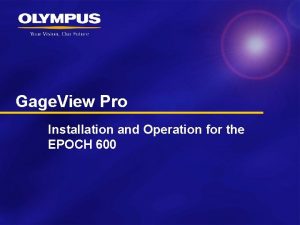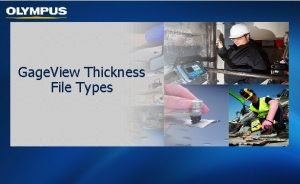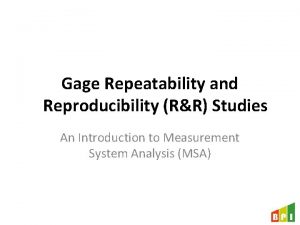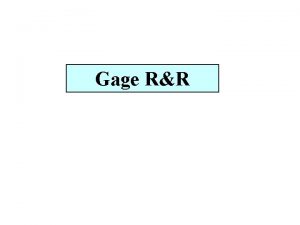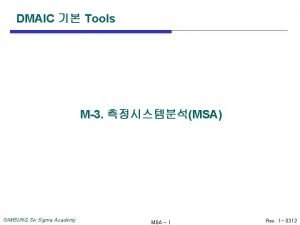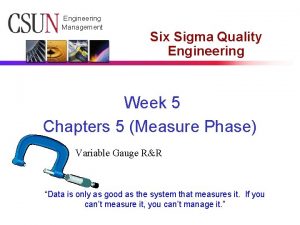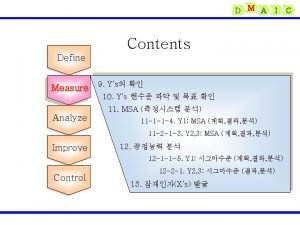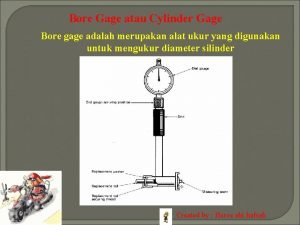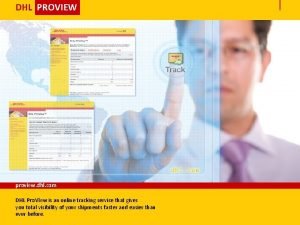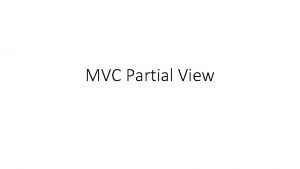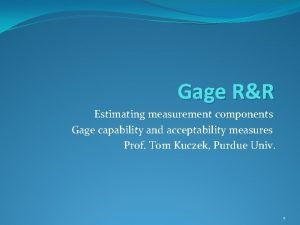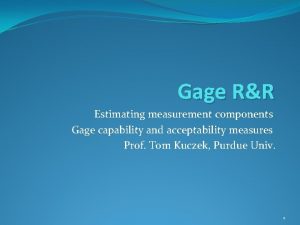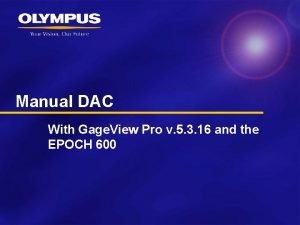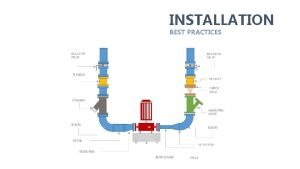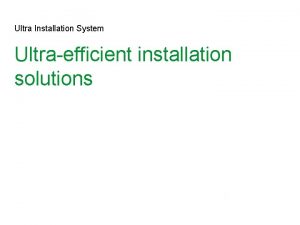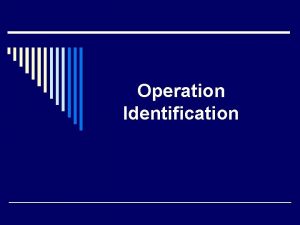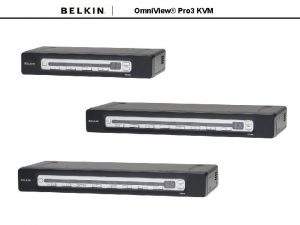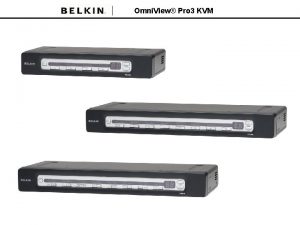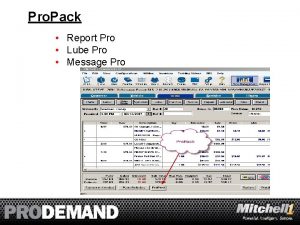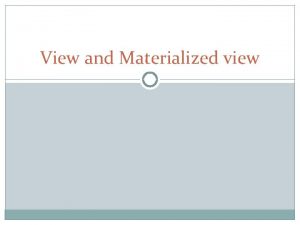Gage View Pro Installation and Operation for the






















































































- Slides: 86

Gage. View Pro Installation and Operation for the EPOCH 600

Gage. View Pro v 5. 3. 5 Installation and Operating System (OS) Support

Gage. View Pro Operating Systems The Gage. View Pro interface program v 5. 3. 5 is compatible with the following Windows operating system (OS) platforms: u u Windows XP (32 bit) Windows Vista (32 bit) Windows 7 (32 bit and 64 bit) Other OS: Olympus NDT does not support operating systems that have been discontinued or are no longer supported by Microsoft

Gage. View Pro System Requirements u Windows XP system requirements - Home & Professional editions: – 233 -megahertz (MHz) processor or faster (300 MHz is recommended) – At least 64 megabytes (MB) of RAM (128 MB is recommended) – At least 300 megabytes (MB) of available space on the hard disk – CD-ROM or DVD-ROM drive – Keyboard and a Microsoft Mouse or other compatible pointing device – Video adapter and monitor with Super VGA (800 x 600) or higher resolution u Windows Vista system requirements - Home Premium, Business and Ultimate editions (Home Basic is not recommended): – 1 gigahertz (GHz) 32 -bit (x 86) processor – 1 gigabyte (GB) of system memory – 40 GB hard drive with at least 300 megabytes of available space – CD-ROM or DVD-ROM drive – Keyboard and a Microsoft Mouse or other compatible pointing device – Video adapter and monitor with Super VGA (800 x 600) or higher resolution u Windows 7 system requirements - Home Premium, Professional, Enterprise and Ultimate editions (Starter & Home Basic are not recommended): – 1 gigahertz (GHz) or faster 32 -bit (x 86) or 64 -bit (x 64) processor – 1 gigabyte (GB) RAM (32 -bit) or 2 GB RAM (64 -bit) – 40 GB hard drive with at least 300 megabytes of available space – CD-ROM or DVD-ROM drive – Keyboard and a Microsoft Mouse or other compatible pointing device – Video adapter and monitor with Super VGA (800 x 600) or higher resolution

Gage. View Pro Installation Use the following procedure to install Gage. View Pro: u Insert the installation CD into the CD-Rom drive. The CD will automatically open the installation screen, shown below: Windows XP u u Windows 7 The installation file will recognize which Windows operating system (OS) is in use and offer selections for that OS only For first time installation, select the Install All option.

Gage. View Pro Installation u u u The following warning message will appear, advising that you uninstall any previous versions before continuing with the installation: – NOTE: If you need the Thickness Gage capabilities of Gage. View, please contact an Olympus NDT representative. The Gage. View Setup Wizard window will appear to walk the user through the remainder of the installation: The following message will appear informing you that the installation contains other components:

Gage. View Pro Installation u The following message or messages may appear to inform you that the installation contains other components:

Gage. View Pro Installation u Select a destination folder for the Gage. View Pro files, and identify whether Gage. View Pro should be accessible by Everyone who uses the computer, or by Just Me (the particular login account currently in use): u Once these selections are made, press Next to begin the installation

Gage. View Pro Installation u For some Windows OS platforms, the following message will appear several times during installation. You must select Install this driver software anyway during the installation process to properly install Gage. View Pro.

Gage. View Pro v 5. 3. 5 Overview

Gage. View Pro v 5. 3. 5 Functions u Gage. View Pro v 5. 3. 5 provides full compatibility with the EPOCH 600. With GVPro and the EPOCH 600, the user is able to: – Download files from the EPOCH 600 to PC – View and Print EPOCH 600 files through Gage. View Pro – Export data from Survey Files to Microsoft Excel – Backup and Restore instrument database – Save Screen Captures – Upgrade EPOCH 600 device software – Manage custom DGS probe library – NOTE: Version 5. 3. 5 of Gage. View Pro does not support file transfers with Template Storage data

GVPro Interface Overview Device Window: Lists all currently configured EPOCH units, USB memory devices, and the files stored within them PC Window: Lists all databases, datasets, and surveys stored on the PC

GVPro Interface Overview- Device Window Currently Configured EPOCH 600 Flaw Detector Files saved on EPOCH 600

GVPro Interface Overview- PC Window Survey/File contained in selected dataset Databases Saved on PC Datasets within selected database

Driver Installation

EPOCH 600 USB Connection u The EPOCH 600 is equipped with a single USB On-the-Go (OTG) port which acts as both a Host and a Client Port used for PC Communication and Printing. u When communicating with a PC and Gage. View Pro, connect the USB OTG port on the EPOCH 600 to a USB port on the PC via the USB cable. – This cable is a Mini AB to Type A/Host (P/N EPLTC-C-USB-A-6) USB On-the-Go Port EPLTC-C-USB-A-6 USB Cable

USB Driver Installation u In order for the EPOCH 600 to communicate with Gage. View Pro, the USB drivers for the instrument must be properly installed on the PC. u The USB drivers will only need to be installed the first time the EPOCH 600 is connected to the PC through a given USB port. u To install the EPOCH 600 USB drivers: 1. Connect the EPOCH 600 to the PC using the USB connector cable. - Make sure that the cable is connected directly into a USB port on the PC, not through a docking station or port replicator. 2. Turn the EPOCH 600 on. This should initiate the Windows New Hardware Installation Wizard.

USB Driver Installation (cont. ) 3. When prompted, select Install the software automatically (Recommended) and press Next. 4. As the install process continues, the screen below will appear informing the user that the EPOCH 600 has not passed Windows Logo testing. Press Continue Anyway to proceed with installation.

USB Driver Installation (cont. ) 5. The following screen will appear requesting the location of the file usbser. sys. The user MUST use the Browse key to select the location of this file. - If Gage. View Pro has been installed to the default directory, the user should browse to the following location to select the required file: C: Program FilesOlympus NDTGage. View Flaw Detector 6. After typing the correct location into the highlight box, or using the Browse key to locate this file, the user should press OK to finish the driver installation.

USB Driver Installation (cont. ) 7. If the EPOCH 600 drivers have properly installed, the screen below will appear. Press Finish to close the hardware installation wizard.

Device Initialization

Device Initialization u Once the USB drivers have been properly installed, the user is now ready to initialize their EPOCH 600 with Gage. View Pro. To initialize the EPOCH 600 in Gage. View Pro: 1. From the main screen, select Device, then Config. u 2. Highlight the EPOCH 600 from the Flaw Detector tab and press Add. – Multiple instruments can be initialized at once if desired. 3. Press OK to exit Device Configuration and initialize the EPOCH 600.

Device Initialization (cont. ) u Once the EPOCH 600 has been properly initialized, it will show under the Device list in the top frame. Files stored on the instruments are displayed by highlighting the device icon: u u Click on the instrument name that appears under Devices The contents of the Datalogger will appear Contents of Datalogger on EPOCH 600

File Wizard

File Wizard The File Wizard is a feature that guides the user through a quick and easy setup of Database and Dataset locations for file transfers. The File Wizard helps to eliminate any confusion for flaw detector users caused by the file structure of Gage. View Pro. File Wizard first creates a Database for the EPOCH instrument being used, then helps the operator select the appropriate type of files to be stored within that database by creating Dataset(s) based on user input. Once completed, Gage. View Pro can immediately accept files from the instrument!

File Wizard u The File Wizard is located in the File menu of the main Gage. View Pro screen.

File Wizard – Database Creation u To enter the Wizard and create database(s), dataset(s) and survey(s) for the EPOCH 600: – Select the EPOCH 600 from the left column – Press Add to select the instrument(s) for setup – Press Next to continue

File Wizard – Database Creation (cont. ) u File Wizard will prompt the user to save the Database on the user’s PC. The default location is in the Data folder in the Gage. View Pro directory. – This file will be set up to house multiple files types for a single instrument. Typical file names include EP 600 or Inspec. Data, etc. – The user has the option of creating as many databases and datasets as necessary to organize their files the way they choose. u Press Save to continue.

File Wizard – Dataset Creation u The File Wizard now prompts the user to select the files types to be stored within this main instrument file. A separate dataset will be created within the database for each of the selected file types. u There are two types of datasets that can be created through the Wizard: – Formatted ID Types have specific, user-defined file structures that require additional setup. When a Formatted ID Type is selected, the user is immediately brought to a new setup screen that requires user input to define the file criteria – Generic Flaw Detector file types will accept all files from the EPOCH 600 and are used as a general storage space for any EPOCH 600 information stored in the datalogger.

File Wizard – Dataset Creation (cont. ) u To add Formatted ID datasets: – Highlight the desired file type from the list on the left – Press the Add button to select the highlighted file type – Enter a file ID Prefix (if desired) and a Point ID (start ID) for the file. – User can select multiple instances of the same file type – Use the Rename button to rename a dataset if desired

File Wizard – Dataset Creation (cont. ) u To add Generic Flaw Detector datasets: – Highlight the desired file type from the list on the left – Press the Add button to select the highlighted file type – User can select multiple instances of the same file type – Use the Rename button to rename a dataset if desired

File Wizard - Completion u When all desired file types have been selected and properly setup, press Finish to create the corresponding Database and Datasets

File Wizard – Completed Wizard u u The Database name created in Step 1 displays below the Data folder in Gage. View Pro. The Datasets created in Step 2 display within the Database and are ready to receive file transfers from the EPOCH 600. – Formatted ID datasets, a blank survey will be created in the dataset. This can be transferred to the EPOCH 600 if desired.

File View Refresh Button u Occasionally, when the Database Wizard or Database/Dataset creation steps are completed, the new Database/Dataset does not immediately appear in the bottom viewing pane of Gage. View Pro. u Gage. View Pro offers a quick Refresh button that allows the user to refresh the screen. This allows the user to view any files which have been created but are not being shown in the viewing pane.

Manual File Structure Setup

Database Setup - Manual u As an alternative to using the Wizard, Gage. View Pro allows the operator to manually set up a Database location on the PC where new Datasets and/or files can be transferred. u To set up a new Database: 1. Under the File menu, select New > Database, -or- 2. Click the New Database icon in the lower Gage. View Pro view pane or

Database Setup – Manual (cont) 2. Highlight the device type (EPOCH 600) from the Device Type list on the left - If necessary, use the Browse button to select the desired file destination 3. Give the Database a name - Note: Spaces and special characters are not permitted in database or dataset names. 4. Press OK to create the Database

Database Setup – Manual (cont. ) u The Database is now created and should appear in the lower Gage. View Pro PC Window view pane.

Dataset Setup - Manual u Gage. View Pro Datasets are specific file storage locations. – Generic flaw detector datasets allow the user to transfer any flaw detector file for a particular instrument to and from Gage. View Pro. – Datasets can also specifically define the file type and structure of files stored within a particular Database. – New blank template files, often called Surveys, can also be created within a Dataset.

Dataset Setup – Manual (cont. ) u Gage. View Pro allows the operator to manually set up Datasets within a Database where files can be stored and/or created. u To set up a new Dataset: 1. Highlight the desired Database location for the new Dataset 2. Under the File menu, select New > Dataset, -or- 2. Click the New Dataset icon in the lower Gage. View Pro view pane or

Dataset Setup – Manual (cont. ) 3. Create a Dataset Name. - Dataset names are typically chosen to reflect either the structure of the files or the type of files to be stored within the Dataset 4. Select the Dataset Type to define the format of the files within the Dataset 5. Use the Note field to add a short description to the Dataset (optional) 6. Press Next to continue.

Dataset Setup – Manual (cont. ) 7. Once a Dataset Name and File Type have been assigned, the user must define the structure of the selected file type. 8. Enter a file ID Prefix (if desired) and a Point ID (start ID) for the INC file, and then press Generate IDs. 9. If satisfied with the generated ID list, press Save to save the current list of ID and then Finish to complete the Dataset setup process.

Dataset Setup – Completion u The new Dataset will appear under its assigned Database in the lower Gage. View Pro view pane. – For incremental (INC) file datasets, a blank survey will be created in the dataset. This can be transferred to the EPOCH 600 if desired. u The Dataset is now ready to accept file transfers of files from the EPOCH 600 u NOTE: Datasets will ONLY store files that match the Dataset file type criteria EXACTLY.

Dataset Setup - Automated u Additionally, a Dataset will be created automatically in Gage. View Pro when a file is dragged from the EPOCH 600 directly into a Database. – Gage. View Pro will automatically create a Dataset with a name and file structure identical to the file transferred from the EPOCH 600.

Files and File Transfers

File Transfers- Downloading Files u u Once a Database and Dataset are setup in Gage. View Pro, files can easily be transferred between Gage. View Pro and a configured EPOCH 600 To download files from the EPOCH 600 to GVPro: u Highlight the file in the Device Window (top pane). u Click and drag this file from the EPOCH to the desired database or dataset created in the PC Window (bottom pane)

File Transfers – Uploading Files u To upload files from the GVPro to the EPOCH 600 1. Highlight the file in the PC Window (bottom pane). 2. Click and drag this file from GVPro to the EPOCH 600 in the Device Window (top pane)

Survey Files u u u When a new Dataset is created with file criteria/structure, a blank data file is automatically generated within that Dataset This blank file is called a Survey file and is named after the Dataset Survey files are template files that have the same file structure as their parent Datasets but have NO inspection data stored in the file Survey files can be renamed and uploaded to the EPOCH instrument multiple times to create empty inspection files on the instrument ready to acquire data within the file structure of a particular Dataset – Allows for easy downloading to the same Dataset for multiple inspections – Allows for logical layout of inspection plan prior to field work Survey files are NOT created with Generic Flaw Detector datasets

Viewing File Data u After downloading a file from the EPOCH LTC, it is easy to view and print the saved data through Gage. View Pro – Double-click on any file stored on the PC to view the file contents File Info Meas. Readings ID List Setup Parameters A-Scan Waveform Gate Info and Flags

Viewing File Data (cont. ) u If a file contains additional data not typically displayed in the main File View menu (e. g. AWS A, B, C values, DAC setup parameters), use the drop-down menu located above the main parameters/calibration data box to view this information.

Copying Waveform Image u Use the Copy Waveform button to copy an image of the displayed waveform and paste into another document.

Printing Reports u Use the Print button to print a report form containing either just digital measurements, or digital measurements accompanied by calibration and waveform data Report Contents (to change, select from menu and press Generate Report) Page (in this view each ID prints on a single page)

Editing and Deleting in Gage. View Pro u Databases, Datasets, and Files can be renamed and/or deleted once they have been created/transferred to Gage. View Pro u To Edit/Rename: 1. In the Edit menu, select Enable Edit 2. Highlight the database/dataset/file to edit and right click 3. Select Rename and enter a new name for the file – u When renaming a database file, make sure to keep the “. LTC” file extension in the database name. To Delete: – – In the Edit menu, select Enable Delete Highlight the item to delete Either right click and select Delete, or Use the Delete icon

Survey Data Exporting

Survey Data Exporting u u 3 Gage. View Pro is capable of exporting data from an EPOCH 600 Survey file to a Microsoft Excel spreadsheet. Exporting can be initiated in three ways: 1. Click the Export button in the File view 2. Right click on the survey file and select Export > Microsoft Excel 3. Drag a Survey file to the Export function in the PC folder list 1 2

Survey Data Exporting u Once the exporting feature is initiated, the Export control screen will appear. The Database file path appears at the top of the screen, and the selected file appears in the Surveys to Export box.

Survey Data Exporting- Export Types u Gage. View Pro allows the user to export up to four types of information from any given file: – ID List – Measurement List – Calibration List – Waveform Images u These data types will display as tabs along the bottom of the Microsoft Excel file when exported.

Survey Data: Export Types – ID List u ID List: This export type provides all displayed digital measurements (up to 4) that were saved with the EPOCH 600 file. – Each saved ID is listed in a separate row, and each column contains measurement information for the ID – Numeric measurements are separated from their corresponding units of measurement by column – Special data (such as A, B, C values for AWS inspections) is also listed if applicable

Survey Data: Export Types – Waveforms u Waveform List: This export type displays the A-Scan/waveform for each ID within the file. – ID Name is listed in Column A – Waveform can be moved, expanded, copied and/or pasted within or outside the spreadsheet – No point data can be exported from Gage. View Pro – Clicking on the Calibrations hyperlink will jump the user to the calibration setup for the corresponding ID.

Survey Data: Export Types – Calibration List u Calibration List: This export type details the instrument calibration and parameter settings for each saved ID in the file. – Data for each ID is separated by column – Each row contains a different parameter » – Each calibration parameter row is consistent across all IDs, despite setup, for easy comparison of settings from ID to ID Clicking on the Waveform hyperlink will jump the user to the waveform for the corresponding ID – Alarm conditions are included if present – Leg information is displayed for angle inspection

Survey Data: Export Types – Measurement List u Measurement List: This export type provides descriptions of the digital measurements made for each ID. The user will need to correlate the numerical measurements from the ID List export with the definitions from the Measurements List tab. – The information for each ID is listed in a separate row, and each column contains measurement information for the ID – Gate measurement mode (Peak, Edge or 1 st Peak) is included for each ID

Survey Data Export Header Information u Each Microsoft Excel worksheet generated by Gage. View Pro contains the same header information at the top of the worksheet. This information is generated from the original file, as set up and stored on the EPOCH 600, and includes: – File Name (Created on EPOCH 600) – File Date (Stored at time of save by EPOCH 600)

Device Tools Menu

Tools Menu u Additional features and functions through Gage. View Pro are found in the Device Tools menu (Device > Tools) u The menu includes the following functions: – – – Database Backup/Restore Screen Capture Terminal Upgrade Device Software DGS Probe Library

Tools Menu – Database Backup/Restore u u The Gage. View Pro Tools Menu allows the user to backup and restore all files saved on the EPOCH 600 using one tool: Backup: The Backup tool requires that an EPOCH 600 Database is already created on the PC (see previous sections on Database creation) – Use the Browse button to locate the EPOCH 600 Database – (file extension *. 600) – Enter a new Dataset name in the box labeled Enter Name for New Backup Dataset – Copies of the saved files on the EPOCH 600 will be stored in this dataset. – Press the Backup button to begin the backup process

Tools Menu – Database Backup/Restore (cont. ) u Restore: The Restore tool requires that the user has already created a New Backup Dataset – Use the Browse button to locate the EPOCH 600 Database – Use the drop-down menu to select the Dataset to be used for Restore » User can only restore from a Dataset that was created during the Backup process – Press the RESTORE button to begin the restore process » WARNING: Restoring the Database will delete all contents currently on the EPOCH 600 and replace with the contents of the backup file

Tools Menu – Screen Capture u The user has the ability to save screen captures of a current EPOCH 600 screen through Gage. View Pro. – u Screen captures can also be saved to the SD card on the unit by pressing [2 nd F], [F 1]. To save a screen capture: 1. Select Screen Capture 2. Press Receive. The currently displayed screen on the EPOCH 600 will show in the screen capture window. 3. Use the Save and Copy buttons to save the image to a file or copy the image to paste to another location.

Tools Menu - Terminal u u The Terminal screen is used primarily for internal Olympus NDT test procedures on the EPOCH 600 instruments. It can also be used for remote communication to the EPOCH 600. – For further information please contact your local Olympus NDT sales representative.

Tools Menu – Upgrade Device Software u The user can use Gage. View Pro to upgrade the EPOCH 600 to a new version, when necessary. These upgrade file(s) will be provided by Olympus NDT.

Tools Menu –Custom DGS Probes u u Gage. View Pro allows the user to define custom Straight Beam and Angle Beam probes for use with the DGS/AVG software option. These probes can be defined and stored in the Gage. View Pro probe library and uploaded to any EPOCH 600. – Define custom probes in the Tools Menu – Define custom probes in the Main View – Edit Custom Probes – Download and Save current probe library from EPOCH 600 – Upload saved probe library to the EPOCH 600 – Create custom probe import file for remote upload of Custom Probes

Tools Menu –Custom DGS Probes (Local) u To define a Custom DGS Probe saved in the Gage. View Pro Library: 1. Press Library to select the local probe library 2. Select the New button in either Custom Straight or Custom Angle 3. Input the required data for the Custom Probe in the screen below 4. When finished, click OK

Tools Menu –Custom DGS Probes (Direct) u To define a Custom DGS Probe directly on a connected EPOCH 600: 1. Press Device to select the EPOCH 600 probe library 2. Select the New button in either Custom Straight or Custom Angle 3. Input the required data for the Custom Probe in the screen below 4. When finished, click OK

Custom DGS Probes Setup – Main View u Custom DGS Probes can also be set up in the main Gage. View Pro window. The PC pane of this main view contains a folder (under the Data folder) called DGS Probe Library. u A Database called Epoch. Custom. Probe. E 6 P exists to store any custom DGS probes even when they are not loaded on the EPOCH 600. u This database is updated when a new “Local” probe is created using the Tools menu

Custom DGS Probes Setup – Main View (cont. ) u To define a custom DGS probe in the Main View: 1. Highlight either the Custom Straight or Custom Angle Dataset 2. Under the File menu, select New > Survey -or- 1. Click the New Survey icon in the lower Gage. View Pro view pane or

Custom DGS Probes Setup – Main View (cont. ) u Input the custom probe data in the window and press OK u The custom probe is now available to upload to any EPOCH 600.

Tools Menu –Custom DGS Probes (Upload) u Once a Custom DGS Probe has been defined through the Tools Menu or main Gage. View Pro menu and stored locally, it can be loaded to the EPOCH 600 in two ways: – Directly upload to a connected EPOCH 600 – Store to an upload file for remote upload

Tools Menu –Custom DGS Probes (Upload) u To upload directly to a connected EPOCH 600, open the DGS Probe Library selections in the Tools menu: – Under View, click the Library radio button – Tick the box next to the desired probe(s) – Press Send To Device

Tools Menu –Custom DGS Probes (Upload) u If the EPOCH 600 is not directly connected to the computer or is not available, it is possible to store the Custom DGS Probe library to a file and upload this without connecting to Gage. View Pro. u To store to a remote upload file, open the DGS Probe Library selections in the Tools menu: – Under View, click the Library radio button – Tick the box next to the desired probe(s) – Press Send To File…

Tools Menu –Custom DGS Probes (Upload) u A file save box pops up to save the DGS probe file – Do not change the file name – Select an easily-accessible directory and press Save u Once the Custom. Probe. bin file is saved to the PC – Copy this file to the EPOCH 600 micro. SD card – Use the Inst Setup > Misc menu on the EPOCH 600 to Copy the DGS Custom Probe File from External SD Card » See EPOCH 600 training PPT for further details

Tools Menu –Custom DGS Probes (Import) u It is also possible to import a Custom DGS Probe library into the Gage. View Pro Library from an EPOCH 600 or Custom. Probe. BIN file u To import from an EPOCH 600 instrument: 1. Press Device to select the connected EPOCH 600 probe library 2. Select the Read From Device button to import the instrument probes 3. Tick the box next to the desired probe(s) 4. Press Add To Library to import the custom probes to the local probe library

Tools Menu –Custom DGS Probes (Import) u It is also possible to import a Custom DGS Probe library into the Gage. View Pro Library from an EPOCH 600 or Custom. Probe. BIN file u To import from a Custom. Probe. BIN file: 1. Press File and select the desired Custom. Probe. BIN probe file 2. Select the Read From File button to import the instrument probes 3. Tick the box next to the desired probe(s) 4. Press Add To Library to import the custom probes to the local probe library

Troubleshooting

Device Initialization Failure u In order for the EPOCH 600 to properly initialize in Gage. View Pro, the port settings on the unit must be properly configured. If not, the user will see a message similar to the one displayed below informing them that the EPOCH 600 has not properly initialized: u Verify the “COM Port” number listed in the dialog box during the failed connection attempt. If it is COM Port 10 or higher, manually reset the Com Port to a lower value using the following steps:

Device Initialization Failure (cont. ) 1. Open the Device Manager by clicking Start > Control Panel>System, and selecting the Device Manager button under the Hardware tab 2. Double-click EPOCH 600 under the Ports (COM & LPT) row

Device Initialization Failure (cont. ) 3. Click the Advanced button under the Port Settings tab 4. Use the COM Port Number drop down menu to select a lower COM Port value that is not in use 5. Turn the EPOCH 600 Off and then On again and retry initialization

Please contact the Flaw Detector group at Olympus NDT with any questions or comments.
 Gageview download
Gageview download Gage view
Gage view Repeatability and reproducibility
Repeatability and reproducibility The macro pro pro maxcharltonmacrumors
The macro pro pro maxcharltonmacrumors Phineous
Phineous Two way anova minitab 17
Two way anova minitab 17 Ndc gage r&r
Ndc gage r&r 800 n
800 n Msa 측정시스템분석
Msa 측정시스템분석 Upc
Upc Terry gage
Terry gage Precision tolerance ratio
Precision tolerance ratio Useful block
Useful block Stream gage
Stream gage Gage pressure
Gage pressure Standard structural steel shapes
Standard structural steel shapes Gage r&r
Gage r&r Gage
Gage O que são funções cognitivas
O que são funções cognitivas Gazzaniga
Gazzaniga Catterall head at risk signs
Catterall head at risk signs Gage r&r
Gage r&r Celeste gage
Celeste gage Niche objectives
Niche objectives Phineas gage youtube
Phineas gage youtube Gage r&r msa
Gage r&r msa Gage definition
Gage definition Gage adalah
Gage adalah Dhl proview login
Dhl proview login Caqh pro view
Caqh pro view Worm's eye angle shot
Worm's eye angle shot Simple view and complex view
Simple view and complex view Simple view and complex view
Simple view and complex view Simple view and complex view
Simple view and complex view Difference between view and partial view in mvc
Difference between view and partial view in mvc Cycle view and push pull view
Cycle view and push pull view Components of os
Components of os Objective of ethics
Objective of ethics Isometric view of hexagon
Isometric view of hexagon Fspos
Fspos Typiska novell drag
Typiska novell drag Tack för att ni lyssnade bild
Tack för att ni lyssnade bild Returpilarna
Returpilarna Shingelfrisyren
Shingelfrisyren En lathund för arbete med kontinuitetshantering
En lathund för arbete med kontinuitetshantering Särskild löneskatt för pensionskostnader
Särskild löneskatt för pensionskostnader Tidbok yrkesförare
Tidbok yrkesförare Anatomi organ reproduksi
Anatomi organ reproduksi Förklara densitet för barn
Förklara densitet för barn Datorkunskap för nybörjare
Datorkunskap för nybörjare Stig kerman
Stig kerman Mall för debattartikel
Mall för debattartikel För och nackdelar med firo
För och nackdelar med firo Nyckelkompetenser för livslångt lärande
Nyckelkompetenser för livslångt lärande Påbyggnader för flakfordon
Påbyggnader för flakfordon Vätsketryck formel
Vätsketryck formel Svenskt ramverk för digital samverkan
Svenskt ramverk för digital samverkan Kyssande vind analys
Kyssande vind analys Presentera för publik crossboss
Presentera för publik crossboss Jiddisch
Jiddisch Vem räknas som jude
Vem räknas som jude Klassificeringsstruktur för kommunala verksamheter
Klassificeringsstruktur för kommunala verksamheter Fimbrietratt
Fimbrietratt Bästa kameran för astrofoto
Bästa kameran för astrofoto Cks
Cks Programskede byggprocessen
Programskede byggprocessen Mat för idrottare
Mat för idrottare Verktyg för automatisering av utbetalningar
Verktyg för automatisering av utbetalningar Rutin för avvikelsehantering
Rutin för avvikelsehantering Smärtskolan kunskap för livet
Smärtskolan kunskap för livet Ministerstyre för och nackdelar
Ministerstyre för och nackdelar Tack för att ni har lyssnat
Tack för att ni har lyssnat Vad är referatmarkeringar
Vad är referatmarkeringar Redogör för vad psykologi är
Redogör för vad psykologi är Stål för stötfångarsystem
Stål för stötfångarsystem Tack för att ni har lyssnat
Tack för att ni har lyssnat Borra hål för knoppar
Borra hål för knoppar Vilken grundregel finns det för tronföljden i sverige?
Vilken grundregel finns det för tronföljden i sverige? Variansen formel
Variansen formel Tack för att ni har lyssnat
Tack för att ni har lyssnat Steg för steg rita
Steg för steg rita Ledningssystem för verksamhetsinformation
Ledningssystem för verksamhetsinformation Tobinskatten för och nackdelar
Tobinskatten för och nackdelar Blomman för dagen drog
Blomman för dagen drog Mästare lärling modell
Mästare lärling modell Egg för emanuel
Egg för emanuel Elektronik för barn
Elektronik för barn
